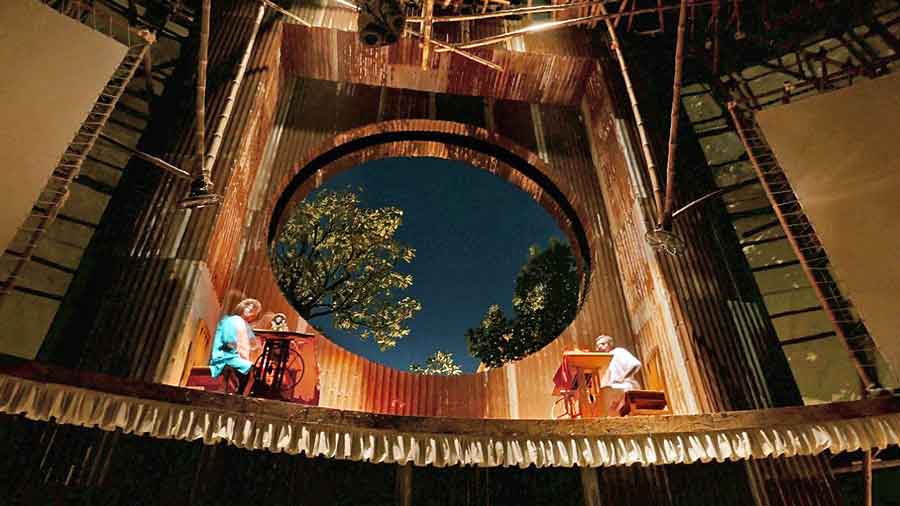Pradip Biswas came from Kalna in Bardhaman to prepare the wooden structures in a pandal.
He and several others, involved in other aspects of the construction, stayed back to become a part of the pandal.
A ground-breaking work at Arjunpur Amra Sabai Club had enthusiasts travelling from across the city to an alley off VIP Road, near Teghoria.
There, on either side of the road, a performance was taking place daily for two weeks that incorporated every bit of the pandal space, including the idol. In the daytime, the place was just a bare ramshackle set, with a circular wooden stage under a tin shed, bamboo towers of various sizes inside the shed and outside, and an idol that curiously stood at a side to reveal a gaping hole in the backdrop.
There was neither gloss nor a trace of colour. But once the sun set and the clock struck six, the space came alive with Biswas and his fellow craftsmen putting up a show by doing what they do for a living.
In a series of performances that ran through the night till dawn, the pandal became a performance space, where carpenters carved away, tailors stitched on sewing machines, a typist pounded away on a mechanical typewriter, and several unseen ones hammered, dragged, lifted, and even lay down to rest at the day’s end or awoke to get on with the next, their forms visible as shadows on white screens hung all around the walls of the tin shed.
All of that produced a soundscape, including the piercing horn of a train, that provided voice to the ballad of their workday routine. It also included songs that spoke of their lives. Onlookers followed the trajectory of the performances, shifting from one corner to another.
When The Telegraph visited the puja on Thursday, Biswas, who had been hammering away atop a tower, had got off his shift, with a colleague taking over for the next two hours.
“We built these towers and that wooden hut. Once our work got over, we were told we would be part of the theme,” he said.
Srimanta Mondal, 26, had come to work on bamboo structures. “Three of us stayed back. We wield a hammer and tug a rope behind the screen,” said the resident of Khejuri, Purba Medinipur. Mondal has worked for big pujas before but never seen such a “living pandal”.
Rakesh Mondal, an agricultural worker from Haringhata, Nadia, came in search of pandal work.
“It is off season in the fields. We are relishing how people are coming in hordes to see us. Some ask what this is about. We explain as best as we can,” smiled the youngster, who has landed the role of a messenger carrying a note from a typist in a tower to a dhol player on another.
“Performances, like drawing of alpana or arati, are built into our rituals. So why should Durga Puja not be used as a setting for performing arts? Otherwise, what is the difference with installations in an art gallery? A pandal is a result of teamwork, so I wanted to involve every craftsman,” said Bhabatosh Sutar, whose brainchild was this uniquely immersive pandal.
“We screened them to see what they could do. For instance, it emerged that some did Chhau dance on the side, so we included a routine but without the costumes.”
There were rehearsals but Sutar insisted that it was no theatre.“It is the story of faceless craftsmen who make visions of us, theme-makers, come alive but vanish after taking their payments on Tritiya. That’s why even Durga is off-centre. Instead, two dhakis take centre stage in the concluding sequence of the 12-minute show,” he said.
